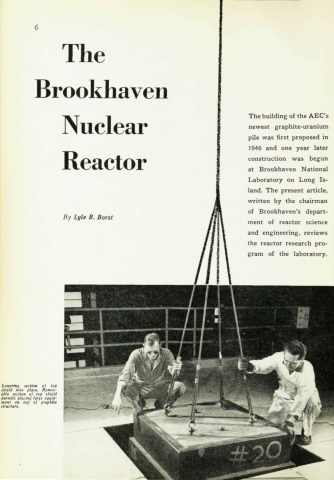The Brookhaven nuclear reactor

On August 22, 1950 the Brookhaven reactor became critical. The work of scientists is notable for its lack of drama. It is usually difficult to say when a piece of apparatus starts to work, and it is even more difficult to decide when an experiment is complete. The uranium chain reaction is outstanding, therefore, since the change from an inert subcritical assembly of fissionable material to a supercritical chain reactor is sudden and, to all intents and purposes, discontinuous.
A small lump of uranium undergoes spontaneous fission of U 238 with a half-life at least a million times that for alpha decay. The rate is so slow as to render measurement difficult. By assembling quantities of uranium in a moderator such as heavy water or graphite, the rate of fission is found to vary with the amounts of material used. Upon adding additional materials, the neutron level at a given position and, of course, the fission rate (partly now in U235 ) increase rapidly at first, then slowly, approaching a new constant level. The steady level may be two, ten, or a million times that to be expected from the spontaneous fission rate.
Brookhaven's reactor was designed to support a substantial and diversified research program. Ample facilities are provided for many simultaneous studies.
Most experiments will be conducted at a number of four-inch square experimental holes extending horizontally through the graphite structure and both shields. These are located at table height above the working balconies to permit convenient handling of research equipment. The neutron flux available at each hole will depend largely upon its position with respect to the center of the reactor. One row of these holes will extend through a region of graphite without uranium. The neutron flux in this internal thermal column will be particularly rich in thermal neutrons and relatively depleted of fast fission neutrons.
These experimental ports may be used for the insertion of equipment into the shield, or into the graphite structure. In these experiments fluxes up to 4 X 10 12 neutrons per cm 2 sec. can be obtained. Under normal circumstances the equipment would reach the ambient temperature of the graphite. For experiments requiring temperature control, heating or cooling can be introduced. The simplest coolingarrangement consists of a duct through the shield which will allow room air to leak around the apparatus and into the cooling air stream. Special cooling systems or thermostatic control can be provided if warranted.
Collimators can be inserted into the shield holes permitting a beam of reactor' radiation to emerge. If unfiltered, these beams contain fast, intermediate, and slow neutrons, and also gamma and beta rays. Filters can be devised to enrich the beam with regard to any of these constituents. Beams can be run to a distance of 40 feet within the building, and to much greater distances outside the building.
A single twelve-inch square hole will accommodate large size experimental equipment. Since this constitutes the largest aperture penetrating a high flux reactor, this facility is expected to be in heavy demand. Equipment must therefore be constructed for easy removal.